
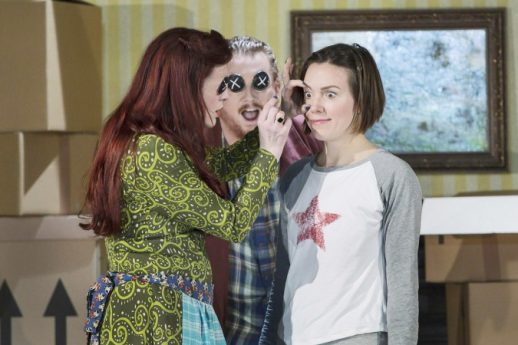
First, because Coraline has already seen several acclaimed adaptations like the comic book by P. Craig Russell (who, ironically, is famous for adapting operas to comic) and the stop-motion animated film by Henry Selick.
Second, engaging kids using a medium like opera, so far from what they are used to, is always difficult. The result? Many compromised are necessary to create an enjoyable spectacle for kids, removing some of the magic from the original work and from an operatic show.
Mullarkey’s libretto does a good job condensing the story of Coraline—a girl who moves into a new house where boredom leads her explore a new dark new world—into two acts of one hour and 45 minutes in total. It retains most of the themes from the original work: boredom, lack of attention/affection, search for adventure, etc.
However, reducing the area of action to only the house loses some contrasts and symbolism associated with those spaces in the book, like the garden as the external world or the bottomless well as the end of the world Coraline is allowed to explore and the end for the Other Mother).
While the novel allowed readers to draw their own inferences, here there is a tendency to over-explain things. For example Coraline says that she is going to visit her neighbor while she is knocking at the door that all the audience already knows belongs that neighbor.
I was startled when I learned that there were not surtitles in this production. How would the kids understand what is being sung if they are not used to operatic vocal style? It looks like Turnagetook this much into account and his vocal writing is focused on clarity of word projection. However, this is done at the expense of richness in the melodic line: they are overly calm, habitually extending the last or the second-to-last syllable in forte.
Characters are melodically differentiated with the most lyrical moments belonging to the pair of retired actresses: they are funny and extravagant in Coraline’s eyes and these qualities are represented through a more florid singing style, closer to belcanto.
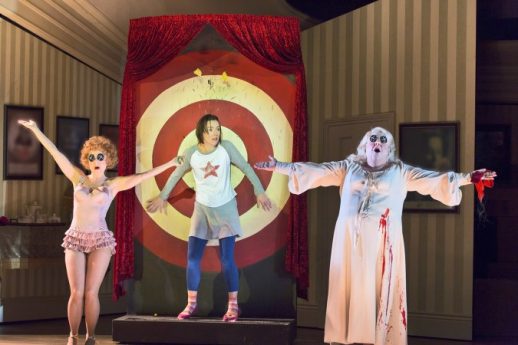
The production by Aletta Collins is well done, skillfully combining different visual aesthetics like steampunk for the robot made by the father or Tim Burton gothic style for the other world. (This style seems borrowed from the film adaptation rather than from the original novel.) The sets represent the various rooms in the bulding, playing with the perspective in an effective way and allowing smooth and clear transitions.
The “other” world is built with all the elements inside the rooms mirroring the position they have in the “real” world. Occasionally the staging seemed gimmicky, as when the “other mother’s” hand walking like the one in the Addams Family. Was the reason for this bit simply to keep the kids interested? What was missing, though, was the visual symbolism present in the novel that made it enjoyable to geeky adults: no mist, no mice vs. rats, no cat, no spider and no stone with a hole.
Mary Bevan was credible as Coraline, without exaggerated childish gestures and movements that sometimes spoil adults’ attempts at playing child roles. Vocally she succeeded at delivering the varying moods of the character. She was at her best in the final scene, when back in the real world she expressed her love for her parents with unbounded joy.
Kitty Whately was initially planed to sing the Mother/Other Mother but she had laryngitis and Robyn Allegra Parton stepped in singing the role from the side of the stage while Kitty walked it on the stage. The solution worked surprisingly well, thanks to the fine acting of Whately and a lip-sync better than most of pop divas can do nowadays.
Alexander Robin Baker was a charismatic Father/Other Father. He has a beautiful baritone voice, with distinctive phrasing and a variety of accents that matched well the expressive role.
Gillian Keith and Frances McCafferty as the actresses were funny in their expressions and did some good lyrical singing. Harry Nicollas Mr Bobo, sacrificed any hint of beauty in the singing in depicting a little old man with a quavery voic.
All in all, the kids in the audience enjoyed the show. One possible challenge in this piece is the decision to have the “good” and “bad” parent characters doubled: for children more accustomed to the realistic portrayals in film, it might be confusing.
I would be very interested, though, to hear from the children in the audience their impressions of the piece: Did they think afterwards about any of themes presented on the opera? Did any moment of the opera come to their minds when facing situations in the real life? Ultimately, did they connect with opera as an art form?
Photos: Stephen Cummiskey















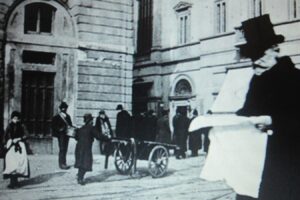
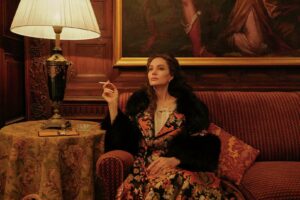

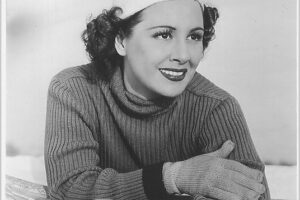






Comments